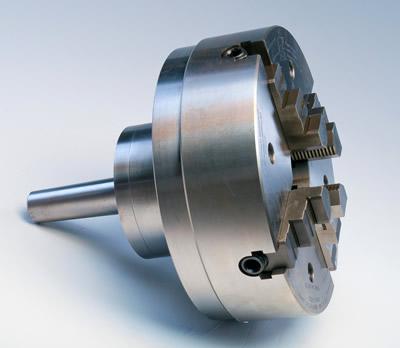
Center holes on roll journals often take a beating during the installation process in a mill. Depending on the repair process, refurbished rolls can end up with journals that are misaligned with the center holes, making future repairs problematic.
Finding the true centerline on a roll with a damaged or misaligned center hole can be difficult and time-consuming. The Live Chuck Mandrel from Riten Industries Inc. solves this problem by chucking on the bearing journals of the part. The design features a "quick-true" system, which makes it easy to locate the roll on the machine's centerline through simple touch-off indication. Compared with live center-supported rolls, users report improved part quality and throughput increases up to 25 percent, according to the company. Typical models feature an extra heavy-duty bearing assembly coupled with either a 3-jaw scroll chuck or a 4-jaw independent chuck. Standard Morse tapers and chuck sizes from 6" to 18" are available. Other configurations can be custom engineered for unique applications.
Contact Details
Related Glossary Terms
- chuck
chuck
Workholding device that affixes to a mill, lathe or drill-press spindle. It holds a tool or workpiece by one end, allowing it to be rotated. May also be fitted to the machine table to hold a workpiece. Two or more adjustable jaws actually hold the tool or part. May be actuated manually, pneumatically, hydraulically or electrically. See collet.
- mandrel
mandrel
Workholder for turning that fits inside hollow workpieces. Types available include expanding, pin and threaded.
- milling machine ( mill)
milling machine ( mill)
Runs endmills and arbor-mounted milling cutters. Features include a head with a spindle that drives the cutters; a column, knee and table that provide motion in the three Cartesian axes; and a base that supports the components and houses the cutting-fluid pump and reservoir. The work is mounted on the table and fed into the rotating cutter or endmill to accomplish the milling steps; vertical milling machines also feed endmills into the work by means of a spindle-mounted quill. Models range from small manual machines to big bed-type and duplex mills. All take one of three basic forms: vertical, horizontal or convertible horizontal/vertical. Vertical machines may be knee-type (the table is mounted on a knee that can be elevated) or bed-type (the table is securely supported and only moves horizontally). In general, horizontal machines are bigger and more powerful, while vertical machines are lighter but more versatile and easier to set up and operate.

